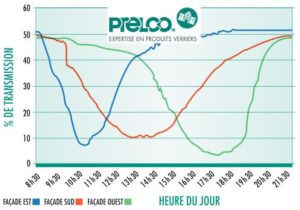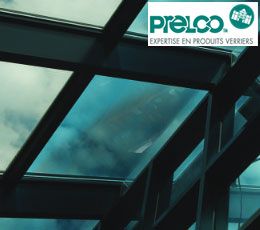The glazing becomes adaptive and connected: it controls the daylight to heat, cool and illuminate better!
Share this page
Operating principles of an adaptive or dynamic glazing
Without knowing it, nothing allows you to distinguish a glazing called dynamic from a conventional glazing: its appearance is neutral and transparent.
According to a common principle we find many similar terms: smart glass, switchable glass, active glass, adaptive glass, dynamic glass.
The glass is called dynamic when its optical qualities of light transmission (therefore its shade) may vary automatically according to the parameters (under the effect of light or heat) or at request (under the effect of an electric current).
There are 3 major families of dynamic glazings:
- The glass called electrochromic consists of a stack of glass layers with special qualities. On some layers the nanoscale coating was applied by pulverisation. 2 transparent layers act as electrodes with intermediate layers. Passing the electric current of very low tension (< 5V direct current) from one electrode to the other creates a transfer of ions and electrons from one layer to the other. A layer is called electrochromic, that is it changes colours under the impulsion of the electric current that passes through it. The resulting effect is darkening of this intermediate layer (often blue). We use mostly ceramic glasses.
- The glass called photochromic is a glass that has the capacity to shade itself according to the quantity of UV that passes through the latter. These are polarising glasses that are used for sunglasses.
- The glass called thermo-chromic is a glass whose optical qualities change automatically according to the temperature. It passes reversibly from a transparent state to a darker state (or reflective) depending on the heat (ambient) detected by the glazing. Therefore we can regulate the temperature of a room. It’s a deposit of an organic film or a metal oxides layer. In the case of home glazing, Vanadium oxide is most promising when doped with tungsten. It makes the material transparent at low temperature (the infrared passes through) and darkens at higher temperature (about 30°C), the infrared is reflected. This way is very promising: the ultimate goal is a solar control that would automatically adjust depending on the season and without energy other than sunlight.

@Prelco thermo-chromic glass dynamic glazing
Expected results and applications of the smart dynamic glazing
The announced advantages are many.
- A better thermal regulation, thus better comfort:
- The idea is to lighten the glass. Clearer it is more it lets the sunlight pass through and heat the room. This configuration is applied for the winter.
- The principle is to darken the glass. More the glass is dark more it absorbs the natural light (and its heat), preventing it to pass through the glass and to enter the room. This configuration is applied for the summer. And avoids the use of low emissivity glazing or even of blinds and shutters.
- Free the creativity of architects since the thermal constraints are reduced.
- Learn more about the thermal comfort.
- Dynamic glazings limit the energy requirements to heat or cool. Smart glasses go in the direction of new thermal regulations and positive-energy building which aim is to use a bioclimatic design and a marginal non renewable energy.
- Improve the quality of natural lighting. A clearer view because the glazing adjusts to the brightness and decreases the backlights and the dazzle. Improve the visual comfort.
- A function of place privatisation for the opacifying glazings (bathroom, meeting room, risk sites, show windows, etc.).
- You can control the degree of shade, its settings and its automatisation by tablets, wall switches or even by voice commands thanks to a centralised building management system!
- The system is maintenance free for the thermo-chromic glasses.
How long does it take to change its shade? The manufacturer Saint Gobain with its SageGlass solution indicates a reactivity period of few seconds. The thermo-chromic glasses have a longer period.
The disadvantages of dynamic glazings:
- The high price. The prices per m2 excluding the installation are from £500 to £700 per m2.
- Saint Gobain indicates that the process is more efficient to cool in summer than the use of shutters. The effect is limited if the temperature in the shade is higher than the comfort room temperature.
- The overweight.
Concerning the building and the housing, the supports and the applications are many: traditional window frames, veranda, windowpanes, façades, glass roofs, …
It is now technically possible to produce glass panels over 3 meters large.
The main applications are: offices, public buildings (schools, libraries …), restaurants and luxury hotels, residential (veranda, windowpanes, housings with lots of windows).
The major manufacturers on the market
SAINT GOBAIN’s SAGEGLASS
It’s been the pioneer of dynamic glazing for over 20 years. The SageGlass® solution is being produced on an industrial scale. The glazings are available in a variety of shapes, colours and configurations (several shade areas on the same glass, degraded shades). The glazing is dynamic depending on the external conditions. SageGlass can range from 60 % (clear state) to 1 % (maximum shade) of light transmission, with a solar factor between 0.38 and 0.04. Saint Gobain announces an energy consumption reduction of about 20% for buildings equipped with this technology. Learn more about SageGlass.
PRELCO PREL-SHADE
PREL-SHADE is a thermo-chromic glass manufactured by the Canadian company PRELCO. It changes its colour and becomes darker when strongly heated by the sun. We talk about SUNTUITIVE glass. When the sun lowers in the evening or when cloudy or when the sun becomes weaker, the glazing adjusts “intuitively” leaving the right quantity of light, therefore heat, to permanently pass through. This glass is suitable for all glazing supports and require no connection nor energy supply for its operation. It takes about 30 minutes for the glass to reach its darkest shade. The sustainability over time is estimated for about 20 years.

@ Preleco prel-shade
SUNCOOL DYNAMIC from PILKINGTON
The SUNCOOL DYNAMIC glass is a laminated safety and thermo-chromic glass. It is therefore able to adapt to various situations of solar radiation, which change during the day and seasons. More frontal (or direct) and so intense the solar radiation is, more the glass will darken.
FOX4


